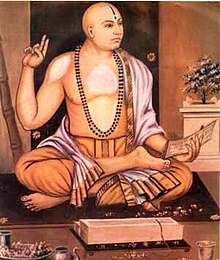Jayatirtha
| Jayatīrtha (ಜಯತೀರ್ಥ) | |
|---|---|
| Religion | Hinduism |
| Order | Vedanta |
| Philosophy |
Dvaita, Vaishnavism |
| Personal | |
| Born |
Dhondupant Raghunatha Mangalwedha, near Pandharpur,[1] Maharashtra or Manyakheta, Karnataka |
| Religious career | |
| Successor | Vidyadhiraja Tirtha |
| Guru | Akshobhya Tirtha |
| Disciple(s) | Vidyadhiraja Tirtha, Vyasatirtha |
| Honors | Ṭīkācārya |
| Part of a series on |
| Dvaita |
|---|
 |
| Saints |
| Haridasas |
| Literature |
| Mathas |
|
| Holy Places |
| Hinduism portal |
Sri Jayatirtha (Śrī Jaya-tīrtha) or Jayateertharu, also known as Teekacharya (Ṭīkācārya) (c. 1365 – c. 1388 [2]) was a Hindu philosopher, dialectician, polemicist and the sixth pontiff of Madhvacharya Peetha. He is considered to be one of the most important seers in the history of Dvaita school of thought on account of his sound elucidations of the works of Madhvacharya. He is credited with structuring the philosophical aspects of Dvaita and through his polemical works, elevating it to an equal footing with the contemporary schools of thought.[3] Along with Madhva and Vyasatirtha, he is venerated as one of the three great spiritual sages, or munitraya of Dvaita.
Born into an aristocratic Deshastha Brahmin family,[4] he later adopted the cause of Dvaita after an encounter with the Madhva saint, Akshobhya Tirtha (d. 1365 [5]). He composed 22 works, consisting of commentaries on the works of Madhva and several independent treatises criticizing the tenets of contemporary schools, especially Advaita, while simultaneously elaborating upon the Dvaita thought. His dialectical skill and logical acumen earned him the distinction of Ṭīkacārya or commentator par excellence. [6]
| Part of a series on | ||
| Hindu philosophy | ||
|---|---|---|
 | ||
| Orthodox | ||
|
|
||
| Heterodox | ||
|
|
||
|
||
Biography
Historical sources on Jayatirtha's life is scant. [1] Most of the information about his life is derived from two hagiographies: Aṇu Jayatīrtha Vijaya and Bṛhad Jayatīrtha Vijaya from his disciple, Vyāsatirtha (not to be confused with Vyasatirtha) and a compilation by Chalāri Saṁkarṣaṇacārya (c. 1700). [7] He was born Dhoṇḍu (or Dhoṇḍo) Pant Raghunath to a Brahmin Deshpande family. The place of his birth is assigned to either Mangalwedha or Manyakheta. [7] According to the hagiographies, his father was a nobleman of military rank and importance. Dhoṇḍo Pant grew up in affluence, with a certain predilection towards sports, especially horse riding.[4] At the age of twenty, after a chance encounter with the ascetic Akshobhya Tīrtha on the banks of river Kagini, he underwent a transformation which led him to renounce his former life, but not without resistance from his family. After much deliberation, his family relented and he was subsequently initiated into the Dvaita fold by Akshobhya Tīrtha, who named him Jayatīrtha. [8] Jayatirtha succeeded Akshobhya as the pontiff in 1365. He composed several commentaries and treatises in the brief span of 23 years between his initiation and death in 1388. The location of his tomb (Brindavana) is a matter of controversy.
Works
There have been 22 works accredited to Jayatirtha, 18 of which are commentaries on the works of Madhvacharya.[9] Nyaya Sudha, which is a commentary on Madhva's Anu Vyakhyana, is considered to be his magnum opus. Running up to 24,000 verses, it discusses and critiques a variety of philosophers and their philosophies, ranging from the orthodox schools of Hinduism like Mimamsa and Nyaya to heterodox schools like Buddhism and Jainism, arguing in favour of Dvaita. [10] Apart from commentaries, he has authored 4 original treatises of which Pramana Paddhati and Vadavali stand apart. Pramana Paddhati is a short monograph on the epistemology of Dvaita dealing with the pramanas in question, theory of truth and error and validity of knowledge while Vadavali deals with the nature of reality and illusion. [11]
Legacy
Jayatirtha occupies a special place in the history of Dvaita Literature. The lucidity and measured style of his writing coupled with his keen dialectical ability has allowed his works to percolate through time, reinforced by the commentaries of later philosophers like Vyasatirtha, Raghavendra Tirtha and Vadiraja Tirtha. Dasgupta remarks "Jayatirtha and Vyasatirtha present the highest dialectical skill in Indian thought".[3] His masterpiece, Nyaya Sudha or Nectar of Logic, deals with refuting an encyclopaedic range of philosophies that were in vogue at the time. Pereira notes "His monumental Nectar of Logic is one of the pinnacles of Indic theological achievement".[12]
Brindavana
Scholarly opinion is divided on the location of Jayatirtha's tomb. Tradition considers Malkhed as the legitimate location of Jayatirtha's mortal remains while some claim that historical evidence and Vadiraja Tirtha's Tirthaprabanda point to Nava Brindavana as the actual location.
References
- 1 2 Sharma 2000, p. 246.
- ↑ Sheridan 1995, p. 236.
- 1 2 Dasgupta 1991, p. viii.
- 1 2 Sharma 2000, p. 247.
- ↑ Sharma 2000, p. 208.
- ↑ Sharma 2000, p. 236.
- 1 2 Dalal 2010, p. 178.
- ↑ Sharma 2000, p. 248.
- ↑ Sharma 2000, p. 249.
- ↑ Sharma 2000, p. 330.
- ↑ Sharma 2000, p. 337.
- ↑ Pereira 1976, p. 123.
Bibliography
- Sharma, B. N. Krishnamurti (2000). A History of the Dvaita School of Vedānta and Its Literature, Vol 1. 3rd Edition. Motilal Banarsidass (2008 Reprint). ISBN 978-8120815759.
- Sheridan, Daniel P (1995). Great Thinkers of the Eastern World. Harper Collins. ISBN 978-0062700858.
- Dasgupta, Surendranath (1991). A History of Indian Philosophy, Vol 4. Motilal Banarsidass. ISBN 978-8120804159.
- Dalal, Roshen (2010). Hinduism: An Alphabetical Guide. Penguin Books India. ISBN 978-0143414216.
- Sharma, B.N.K (2001). Nyayasudha of Sri Jayatirtha (3 vols). Vishwa Madhva Parishad. ASIN B0010XJ8W2.
- Pereira, Jose (1976). Hindu theology: A reader. Image Books. ISBN 978-0385095525.